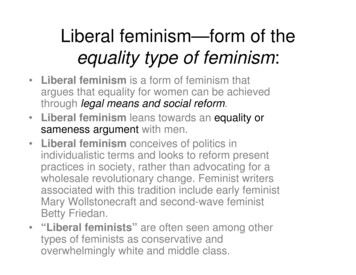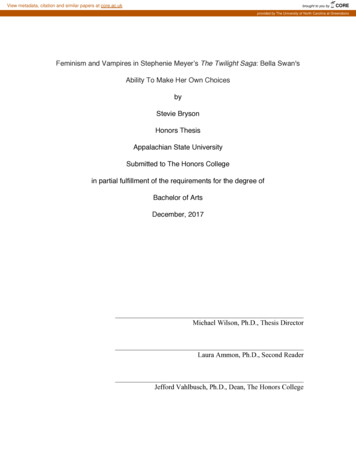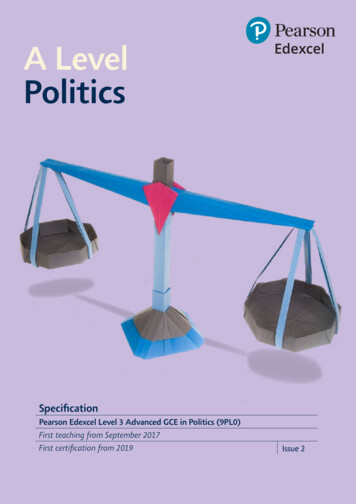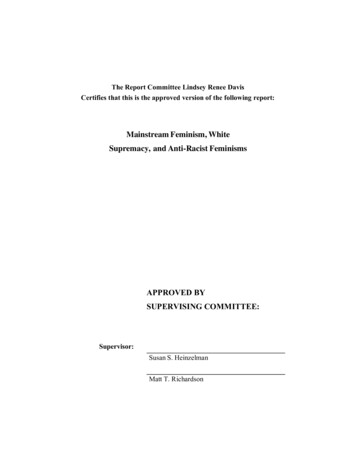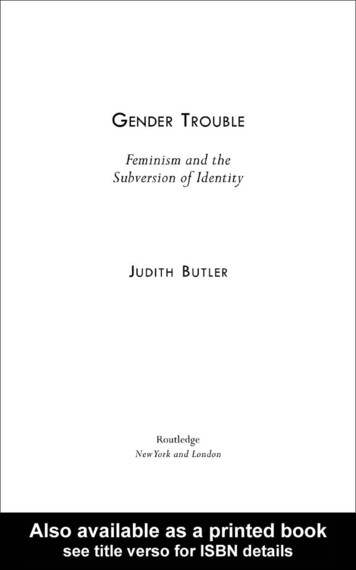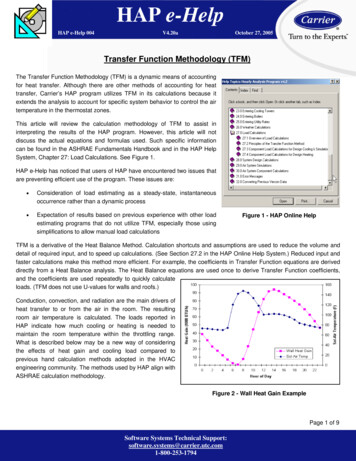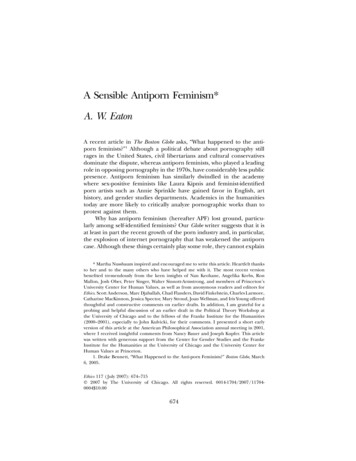
Transcription
A Sensible Antiporn Feminism*A. W. EatonA recent article in The Boston Globe asks, “What happened to the antiporn feminists?”1 Although a political debate about pornography stillrages in the United States, civil libertarians and cultural conservativesdominate the dispute, whereas antiporn feminists, who played a leadingrole in opposing pornography in the 1970s, have considerably less publicpresence. Antiporn feminism has similarly dwindled in the academywhere sex-positive feminists like Laura Kipnis and feminist-identifiedporn artists such as Annie Sprinkle have gained favor in English, arthistory, and gender studies departments. Academics in the humanitiestoday are more likely to critically analyze pornographic works than toprotest against them.Why has antiporn feminism (hereafter APF) lost ground, particularly among self-identified feminists? Our Globe writer suggests that it isat least in part the recent growth of the porn industry and, in particular,the explosion of internet pornography that has weakened the antiporncase. Although these things certainly play some role, they cannot explain* Martha Nussbaum inspired and encouraged me to write this article. Heartfelt thanksto her and to the many others who have helped me with it. The most recent versionbenefited tremendously from the keen insights of Nan Keohane, Angelika Krebs, RonMallon, Josh Ober, Peter Singer, Walter Sinnott-Armstrong, and members of Princeton’sUniversity Center for Human Values, as well as from anonymous readers and editors forEthics. Scott Anderson, Marc Djaballah, Chad Flanders, David Finkelstein, Charles Larmore,Catharine MacKinnon, Jessica Spector, Mary Stroud, Joan Wellman, and Iris Young offeredthoughtful and constructive comments on earlier drafts. In addition, I am grateful for aprobing and helpful discussion of an earlier draft in the Political Theory Workshop atthe University of Chicago and to the fellows of the Franke Institute for the Humanities(2000–2001), especially to John Kulvicki, for their comments. I presented a short earlyversion of this article at the American Philosophical Association annual meeting in 2001,where I received insightful comments from Nancy Bauer and Joseph Kupfer. This articlewas written with generous support from the Center for Gender Studies and the FrankeInstitute for the Humanities at the University of Chicago and the University Center forHuman Values at Princeton.1. Drake Bennett, “What Happened to the Anti-porn Feminists?” Boston Globe, March6, 2005.Ethics 117 ( July 2007): 674–715䉷 2007 by The University of Chicago. All rights reserved. 0014-1704/2007/117040004 10.00674
EatonA Sensible Antiporn Feminisim675why antiporn feminism, in particular, has waned, while culturally conservative opponents of pornography are gaining influence.2I’d like to offer another explanation, namely, that over the yearsAPF has gained a bad reputation. Nowadays “antiporn feminism” conjures images of imperious and censorial finger-waggers who mean topolice every corner of our erotic imaginations. Their insistence thatpornography is harmful to women is considered overly simplistic, whiletheir proposed remedy for this putative harm is taken to flagrantly violate the First Amendment.In some instances this caricature is well deserved. However, I makethe case that on certain key issues this criticism rests on a misunderstanding. It is part of the point of this article to critically examine theterms in which the pornography debate is framed and to expose confusions resulting from lack of precision on many levels. By clarifyingterms like ‘pornography’, ‘cause’, and ‘harm’, I aim to sift out irrelevantand uncharitable criticisms of APF. But this is only part of my purposehere, for, as I mentioned, the caricature is partially warranted. I believethat APF has not presented its best arguments, has suffered from imprecision and subtlety in its delineation of pornography’s harms, hasrefused to acknowledge the limits of its evidence for these putativeharms, and has proposed remedies that are extreme, overly broad, andmurky. In this article I will expose these flaws and point the way towardcorrecting them. In so doing, I hope to convince you that APF can bea sophisticated and reasonable position that is both supported by apowerful intuitive argument and sensitive to the complexities of theempirical data regarding pornography’s effects. It can be, in a word,‘sensible’.My investigation will take the following shape. Section I providesan argument for APF and outlines some of its central tenets. Section IIdisentangles the various sorts of injury that pornography is thought tocause, exposing a wide array of harms that vary considerably in theircharacter and severity. Section III examines the most common criticismsof APF and argues that they can be deflected by attributing to APF amore sensible conception of causation. Section IV assesses the currentstate of the evidence for APF’s case and outlines a path for futureresearch. Section V addresses some lingering objections and suggests2. For instance, in February of 2005, the Justice Department announced that it wouldappeal a recent decision by a federal judge that declared federal obscenity laws unconstitutional. In March of 2005, Attorney General Alberto Gonzales listed “the aggressiveprosecution of purveyors of obscene materials” among his top priorities. See “PreparedRemarks of Attorney General Alberto R. Gonzales,” Hoover Institution Board of OverseersConference, February 28, 2005. Available at the attorney general’s page on the Departmentof Justice Web site: http://www/usdoj.gov/ag/.
676EthicsJuly 2007some problems for further reflection, while Section VI provides a briefconclusion.I. THE HARM HYPOTHESISLet’s begin with the vexing term ‘pornography’.3 Some antiporn feminists construe the term so broadly as to encompass all forms and genres.This position has been justly criticized for ignoring the often liberatorypower dynamics that characterize much gay and lesbian pornography,S/M (sadomasochistic) pornography, and pornography made by andfor women.4 To account for such differences, a sensible APF restrictsitself to inegalitarian pornography:5 sexually explicit representations thatas a whole eroticize relations (acts, scenarios, or postures) characterizedby gender inequity.6 Although this category overlaps significantly with3. There are important debates about how to define the concept of “pornography”and distinguish it from neighboring categories like “erotic art.” For treatments of thedifficulties in distinguishing works of pornography from works of art, see Lynda Nead,The Female Nude: Art, Obscenity, and Sexuality (London: Routledge, 1992), and “‘Above thePulp-Line’: The Cultural Significance of Erotic Art,” in Dirty Looks: Women, Pornography,Power, ed. Pamela Church Gibson and Roma Gibson (London: British Film Institute, 1993),144–55; Susan Kappeler, The Pornography of Representation (Minneapolis: University of Minnesota Press, 1986); Walter Kendrick, The Secret Museum: Pornography in Modern Culture(Berkeley: University of California Press, 1996); and Lynn Hunt, ed., The Invention ofPornography: Obscenity and the Origins of Modernity (New York: Zone, 1996). For a recentdefinition of pornography in the philosophical literature, see Michael Rea, “What Is Pornography?” Noûs 35 (2001): 118–45.4. For discussions of varieties of pornography that do not fit the standard antipornfeminist picture, see Richard Dyer, “Idol Thoughts: Orgasm and Self-Reflexivity in GayPornography,” in More Dirty Looks: Gender, Pornography, and Power, ed. Pamela Church Gibson(London: British Film Institute, 2004), 102–9; Claire Pajaczkowska, “The HeterosexualPresumption,” in The Sexual Subject: A Screen Reader in Sexuality, ed. Terry Threadgold andAnnette Kuhn (London: Routledge, 1992), 184–96; Cindy Patton, “Visualizing Safe Sex:When Pedagogy and Pornography Collide,” in inside/out: Lesbian Theories, Gay Theories, ed.Diana Fuss (London: Routledge, 1991), 373–86; Becki Ross, “‘It’s Merely Designed forSexual Arousal’: Interrogating the Indefensibility of Lesbian Smut,” in Feminism and Pornography, ed. Drucilla Cornell (Oxford: Oxford University Press, 2000), 264–317; and AnnSnitow, “Mass Market Romance: Pornography for Women Is Different,” in Passion andPower: Sexuality in History, ed. Kathy Peiss and Christina Simmon (Philadelphia: TempleUniversity Press, 1989), 245–63.5. Larry May is, to my knowledge, the only antiporn feminist to explicitly restrict thearea of concern in this way—his term is “non-egalitarian”—although he does not offer adefinition. See Larry May, Masculinity and Morality (Ithaca, NY: Cornell University Press,1998), chap. 4, esp. 77.6. A few points of clarification. A work that includes a few scenes that eroticizeinegalitarian relations but in which these are balanced or outweighed by other kinds ofscenes—imagine, e.g., a story of a heterosexual couple who take turns in submissive roleswhile the partner plays the dominant role—would not count as “inegalitarian pornography.” Also, I use “gender inequality” in the standard way to refer to the subordination ofwomen; it does not refer to situations where men are subordinate to women. Thanks toan anonymous referee for pressing me to clarify these points.
EatonA Sensible Antiporn Feminisim677violent pornography, the two are not coextensive, since some pornography eroticizes sexual relations that are violent but not inegalitarian,while other pornography is deeply degrading to women but not at allviolent.Antiporn feminism connects inegalitarian pornography (hereaftersimply “pornography”) to harm in several ways. First, it distinguishesthe harms occurring in the production of pornography (e.g., the variouskinds of coercion, brutality, rape, and other exploitation sometimesinflicted upon women in making porn) from those that occur postproduction. Second, among postproduction harms, some antiporn feminists distinguish the charge that pornographic materials themselvesconstitute harm, in the manner of hate speech,7 from the claim thatexposure to such representations causes harm. This article focuses onthis last kind of harm, which is always indirect, that is, it is always mediated through a second party, namely, the consumer of pornography.The basic idea is that pornography shapes the attitudes and conduct ofits audience in ways that are injurious to women. I shall refer to this asthe “harm hypothesis.”The best argument for the harm hypothesis can be summed up injust a few steps as follows:87. In earlier works, Catharine MacKinnon suggests not just that exposure to pornography causes harm, but that pornography itself “is a harm” (Feminism Unmodified: Discourseson Life and Law [Cambridge, MA: Harvard University Press, 1987], 177) or is “an act ofmale supremacy” (ibid., 154). She elaborates this view that pornography is itself an act ofharm—and not just causally tied to acts of harm—in Only Words (Cambridge, MA: HarvardUniversity Press, 1993), where she uses hate speech as a model for the way in whichpornographic materials themselves can do damage. As a theoretical underpinning for thisview, MacKinnon makes use of J. L. Austin’s concept of performative utterances. A pornographic representation, according to MacKinnon, constitutes an act of subordinationperformed by verbal or pictorial utterances. This should be distinguished from consideringpornographic representations as perlocutionary acts of subordination, in which the harmis a consequence of exposure to pornography. It should be noted that MacKinnon thinksthat pornographic representations have both perlocutionary and illocutionary force, i.e.,that pornography both is a harm and causes harm. Rae Langton offers a similar account.Several feminists question the identification of pornographic representations as performative utterances (see Rae Langton, “Speech Acts and Unspeakable Acts,” Philosophy &Public Affairs 22 [1993]: 293–330). Cynthia Stark, e.g., convincingly argues that MacKinnonfails to explain how pornographic representations themselves can be acts and, further,that her criticism of pornography in these terms actually collapses back into her view thatconsumption of pornography is causally tied to harmful attitudes and conduct. That is,Stark argues that MacKinnon’s construal of the harm is ultimately of the perlocutionary,causal sort (Cynthia Stark, “Is Pornography an Action? The Causal vs. the Conceptual Viewof Pornography’s Harm,” Social Theory and Practice 23 [1997]: 277–307).8. My outline has been influenced by Joshua Cohen’s reconstruction of CatharineMacKinnon’s argument ( Joshua Cohen, “Freedom, Equality, and Pornography,” in Justiceand Injustice in Law and Legal Theory, ed. Austin Sarat and Thomas Kearns [Ann Arbor:University of Michigan Press, 1996], 99–137, esp. 103–5), although I depart from Cohen’sreconstruction in several significant ways, noted below.
678EthicsJuly 2007i) Our society is marked by gender inequality in which women(and girls, although I shall say only “women” for ease of exposition)suffer many disadvantages as compared with men (and boys). This inequality is evident in both individuals’ attitudes and conduct and ininstitutional practices.9ii) This is a grave injustice.iii) Whether or not it is natural, the subordination of women isnot inevitable but rather is sustained and reproduced by a nexus ofsocial factors that range from the explicit (as in the denial of rights andprivileges and other overt discrimination) to the very subtle. An important example of these more subtle means of subordination are themany ways in which children are socialized from an early age to “appropriate” gender roles, according to which boys should be masculine(i.e., self-confident, independent, courageous, physically strong, assertive, and dominant) and girls should be feminine (i.e., demure, passive,submissive, delicate, and self-sacrificing).10 The modi operandi of thissocialization include religion, the household division of labor, and theinfluence of various representational forms such as advertisements, television, movies, popular music and music videos, fashion magazines, andhigh art, all of which often promote masculinity and femininity as idealsfor men and women, respectively. Violence and force (as well as thethreat of violence and force) also play a significant active role in maintaining gender norms and the subordination of women; that is, sexualassault enforces gender inequality and is not merely a symptom of it.11iv) Aspects of gender inequality have erotic appeal for many people. This can be seen, for example, in the way that gender stereotypes,such as dominance and strength for men and softness and submissiveness for women, standardly serve as markers of sexiness. At the extreme9. For example, women are discriminated against in employment and are on averagepaid less than men; they typically bear the greater burden of child care and householdchores; their reproductive freedom is restricted or constantly under threat of restriction;they are subject to various forms of sexual harassment in the workplace and other publicarenas; and they endure, or at the very least are under the constant threat of, rape, battery,and incest both inside and outside the home. These are just some of the ways that women,simply because they are women, occupy a subordinate position in our society.10. Catharine MacKinnon, e.g., describes femininity as “a self who is ingratiating andobsequious and imitative and aggressively passive and silent” (MacKinnon, Only Words, 7).11. Susan Brownmiller provided the first thorough and eloquent explanation of sexualviolence’s function as a means to keep women in a state of fear and thereby perpetuatemale dominance in Against Our Will: Men, Women and Rape (New York: Simon & Schuster,1975). For a more recent account of sexual violence as a technique for maintaining genderinequality, see Wendy Stock, “Feminist Explanations: Male Power, Hostility, and SexualCoercion,” in Sexual Coercion: A Source-Book on Its Nature, Causes, and Prevention, ed. ElizabethGrauerholz and Mary Koralewski (Lexington, MA: Lexington Books, 1991), 29–44.
EatonA Sensible Antiporn Feminisim679end of the spectrum of gender inequality, nonconsensual violenceagainst women is sexually stimulating for many.v) Like gender inequality itself, the erotic appeal of unequal relations between the sexes is not inevitable, regardless of whether it isnatural. Rather, this particular form of sexual desire is fostered by variouskinds of representations, from fashion magazines to high art.12vi) Eroticizing gender inequality—its mechanisms, norms, myths,and trappings—is a particularly effective mechanism for promoting andsustaining it.13 Its efficacy stems from several factors: (a) Transforminggender inequality into a source of sexual gratification renders this inequality not just tolerable and easier to accept but also desirable andhighly enjoyable. (b) This pleasure to which gender subordination islinked is one in which nearly all humans are intensely invested, therebystrengthening gender inequality’s significance and broadening its appeal. (c) This eroticization makes gender inequality appealing to menand women alike. Insofar as women want to be attractive to men, theyinternalize the subordinating norms of attractiveness and thereby collaborate in their own oppression.14 (d) Finally, sexualizing gender inequality enlists our physical appetites and sexual desires in favor ofsexism. Since these are rarely, if ever, amenable to control via rationalscrutiny, harnessing our appetites and desires to gender inequality is aneffective way of psychologically embedding it.vii) Pornography eroticizes the mechanisms, norms, myths, andtrappings of gender inequality. Its fusing of pleasure with subordinationhas two components: (a) it does so in terms of its representational12. Here I disagree with Joshua Cohen, who frames the argument in strongly socialconstructivist terms (Cohen, “Freedom, Equality, and Pornography,” 104–5). As I arguebelow, APF need not take a social-constructivist stance.13. This idea was first suggested by John Stuart Mill in The Subjection of Women (1869;Indianapolis: Hackett, 1988), although most antiporn feminists do not acknowledge thisdebt. However, David Dyzenhaus (in “John Stuart Mill and the Harm of Pornography,”Ethics 102 [1992]: 534–51) does provide an explicitly Millian characterization of the harmcaused by pornography, although he misses the point about pornography’s eroticizationof sexism and instead criticizes pornography by appeal to Mill’s conception of falseconsciousness.14. This idea also goes back to Mill who noted that “the object of being attractive tomen [has] become the polar star of feminine education and formation of character” (Mill,The Subjection of Women, 16). As a “means of holding women in subjection,” he points tothe representation of “meekness, submissiveness, and resignation of all individual will intothe hands of a man, as an essential part of sexual attractiveness” (Mill, The Subjection ofWomen, 16). MacKinnon expresses a similar view when she notes that the sexualization ofgender inequality “organizes women’s pleasure so as to give us a stake in our own subordination” (MacKinnon, Feminism Unmodified, 7). Both are clearly thinking of heterosexualwomen, although the point also stands for bisexual women as well. The fact that the pointdoes not apply to lesbians is part of what some, like Monique Wittig, see as the feministpromise of lesbianism.
680EthicsJuly 2007content by depicting women deriving sexual pleasure from a range ofinegalitarian relations and situations, from being the passive objects ofconquest to scenarios of humiliation, degradation, and sexual abuse;(b) inegalitarian pornography presents these representations of subordination in a manner aimed to sexually arouse.15The argument concludes that, by harnessing representations ofwomen’s subordination to a ubiquitous and weighty pleasure, pornography is especially effective at getting its audience to internalize its inegalitarian views. This argument trades on a conviction dating back toAristotle that still has currency in the philosophy of art today, namely,that understanding and appreciating representations often requires animaginative engagement that can have lasting effects on one’s character.16 Many representations enlist from their audience emotional responses that are ethically relevant. In so doing, they activate our moralpowers and enlarge our ethical understanding by training our emotionsto respond to the right objects with the proper intensity. Such representations not only affect the audience during actual engagement withthe representation but may also have lasting effects on one’s characterby shaping the moral emotions. A similar conviction appears to underliemodern-day sex therapy, where pornographic representations are prescribed in order to mold patients’ sexual inclinations and thereby treatvarious sexual dysfunctions. If representations can in this way improveone’s character, then we should also expect them to be capable ofdeforming it by “perverting the sentiments of the heart,” as Hume putsit.17 Antiporn feminists hold that pornography perverts the emotionallife of its audience by soliciting very strong positive feelings for situationscharacterized by gender inequality and in so doing plays a role in sustaining and reproducing a system of pervasive injustice.It should be noted that this argument pertains to pornography’s15. Note that the two components of this fusing do come apart. A representationmight depict women desiring humiliation and sexual abuse but criticize this as unsavoryor disgusting.16. Aristotle presents these ideas in the Rhetoric and the Politics, and David Humeexpresses something similar in “Of the Standard of Taste,” in Essays Moral, Political, andLiterary (1777), ed. Thomas Hill Green and Thomas Hodge Grose (Indianapolis: LibertyFund, 1985), 226–49. For contemporary versions of this view, see Wayne Booth, The Company We Keep: An Ethics of Fiction (Berkeley: University of California Press, 1988); NoëlCarroll, “Art, Narrative, and Moral Understanding,” in Aesthetics and Ethics: Essays at theIntersection, ed. Jerrold Levinson (Cambridge: Cambridge University Press, 1998), 126–60,and “Moderate Moralism,” British Journal of Aesthetics 36, no. 3 ( July 1996): 223–38; andMartha Nussbaum, “‘Finely Aware and Richly Responsible’: Moral Attention and the MoralTask of Literature,” Journal of Philosophy 82 (1985): 516–29, Love’s Knowledge: Essays onPhilosophy and Literature (Oxford: Oxford University Press, 1990), and “Exactly and Responsibly: A Defense of Ethical Criticism,” Philosophy and Literature 22 (1998): 343–65.17. Hume, “Of the Standard of Taste,” 247.
EatonA Sensible Antiporn Feminisim681adverse consequences for women and that this starkly distinguishes itfrom the arguments of those who disapprove of pornography becauseit offends religious beliefs or social mores.18 The peculiarly feministobjection is not that pornography is sinful, obscene, impolite, lewd,shameful, or disgusting but instead that pornography causes womenharm in the sense that it impairs or thwarts their capacity to pursuetheir interests.19 Before we can see just which interests inegalitarianpornography purportedly thwarts and how, I need to deflect some worries about the argument.1. First, it is important to note that the problem with inegalitarianpornography is not simply that it depicts women being degraded andsubordinated; rather, the problem is that inegalitarian pornography endorses and recommends women’s subordination and degradation.20This point is frequently misunderstood by critics of APF,21 at least inpart because some antiporn feminists themselves confuse mere repre18. In proclaiming that pornography is “Not a Moral Issue” (in MacKinnon, FeminismUnmodified, 146–62), MacKinnon means to distinguish her concerns about pornographyfrom those that motivate obscenity legislation, although this may seem an odd way ofputting the point since harm is usually a moral issue. As Helen Longino puts it, “Pornography is immoral because it is harmful to people” (Helen Longino, “What Is Pornography?” in Take Back the Night: Women on Pornography,” ed. Laura Lederer [New York: WilliamMorrow, 1980], 40–54, 42).19. A modified version of Joel Feinberg’s analysis of harm serves well to capture theantiporn feminist criticism of pornography. According to Feinberg, A harms B when (1)A acts . . . (2) in a manner which is defective or faulty in respect to the risks it createsto B. . . and (3) A’s acting in that manner is morally indefensible . . . and (4) A’s actionis the cause of a setback to B’s interest, which is also (5) a violation of B’s right ( JoelFeinberg, Harm to Others: The Moral Limits of the Criminal Law [Oxford: Oxford UniversityPress, 1984], 105). The important modification upon which I and many other feministsinsist is that “interest” be understood in a nonpsychological and nonrelativisitc sense suchthat a person can have an interest in X even if she does not care about, or even knowabout, X. For a discussion see May, Masculinity and Morality, 61–63; and also see MarthaNussbaum on adaptive preferences in Women and Human Development: The Capabilities Approach (Cambridge: Cambridge University Press, 2000), esp. chaps. 1 and 2.20. Longino makes this point clearly and concisely when she writes: “Pornography isnot just the explicit representation or description of sexual behavior, nor even the explicitrepresentation or description of sexual behavior which is degrading and/or abusive towomen. Rather, it is material that explicitly represents or describes degrading and abusivesexual behavior so as to endorse and/or recommend the behavior as described” (Longino, “WhatIs Pornography?” 45; my emphasis).21. For example, Lynne Segal makes this mistake when she writes: “We are, it is true,ubiquitously surrounded by images and discourses which represent women as passive,fetishised objects and men as active, controlling agents. . . . They saturate all scientificand cultural discourses of the last hundred years—from sexology, embryology and psychoanalysis to literary and visual genres, high and low. . . . Men don’t need pornographyto encounter these ‘facts’ of crude and coercive, promiscuous male sexualities, or helplessand yielding, nurturing female sensitivities” (Lynne Segal, “Does Pornography Cause Violence? The Search for Evidence,” in Church Gibson and Gibson, Dirty Looks, 5–21, 18–19).
682EthicsJuly 2007sentation with advocacy.22 But this is a mistake: a depiction of subordination or degradation is not by itself an endorsement of that subordination or degradation.The pornographic endorsement of gender inequity has three essential ingredients, the first two of which pertain to representationalcontent: (a) strong indications that subordinating, degrading, or objectifying acts are pleasurable both for the perpetrators and the womenwho are the objects of those acts and (b) the suggestion that such treatment is acceptable and even merited. But there is more to pornography’sendorsement:23 (c) inegalitarian pornography also eroticizes this degrading and objectifying picture of women. By employing conventionalsigns and codes of erotic representation, for example, sexual explicitnessconjoined with particular postures, scenarios, outfits, or music andsound (obviously not all apply to each medium), pornography aims tokindle carnal appetites and arouse sexual desire. In sum, pornographyendorses by representing women enjoying, benefiting from, and deserving acts that are objectifying, degrading, or even physically injuriousand rendering these things libidinally appealing on a visceral level. And,as any advertiser will tell you, making something sexy is among the mosteffective means of endorsement.242. The argument is sensitive to the wide range of degrees of genderinequity that pornography eroticizes: whereas some nonviolent repre22. For instance, Susan Wendell (“Pornography and Freedom of Expression,” in Pornography and Censorship, ed. David Copp and Susan Wendell [Buffalo, NY: Prometheus,1983], 167–83) continually employs the disjunction “recommends, condones, or portraysacts of rape” as if all of these were equally problematic from a feminist perspective. Butif “portray” means something akin to “depict,” as one might reasonably suppose, then theproblem with portraying rape is not at all clear. A feminist documentary, e.g., might portrayrape in order to reveal its horrors. Wendell appears to confuse merely describing X withadvocating X, and Alan Soble rightly criticizes her and other antiporn feminists for thisconfusion (Alan Soble, “Pornography: Defamation and the Endorsement of Degradation,”in Pornography: Private Right or Public Menace? 2nd ed., ed. Robert Baird and Stuart Rosenbaum [Amherst, NY: Prometheus, 1998], 134–48, 139ff.).23. Longino maintains that these two features—representing degradation as pleasurable and acceptable—are “sufficient to constitute endorsement of the represented behavior” (Longino, “What Is Pornography?” 43–44). Soble takes issue with this, arguingthat linking degradation with pleasure does not necessarily endorse it (Soble, “Pornography,” 134–45, esp. 141–42). It should be noted that Soble does not discuss the secondpart of Longino’s sufficient condition, namely, that “there is no suggestion that this sortof treatment of others is inappropriate to their status as human beings” [Longino, “WhatIs Pornography?” 43–44]). Longino does miss an important aspect of pornography’s endorsement, namely, its eroticization of the conduct represented. This additional feature,which I contend is essential to the pornographic endorsement, meets Soble’s objection.24. This may be what Larry May has in mind when he likens the pornographicendorsement to subliminal methods used in advertising (May, Ma
Antiporn feminism has similarly dwindled in the academy . police every corner of our erotic imaginations. Their insistence that . Temple University Press, 1989), 245-63. 5. Larry May is, to my knowledge, the only antiporn feminist to explicitly restrict the area of concern in this way—his term is "non-egalitarian"—although he does .
